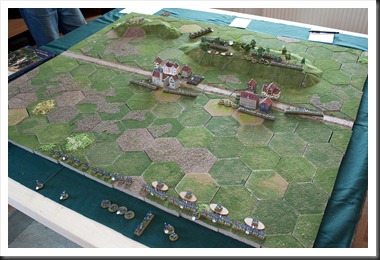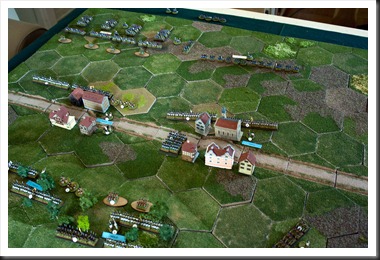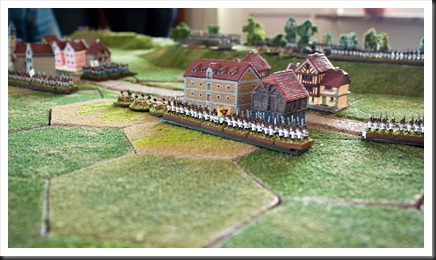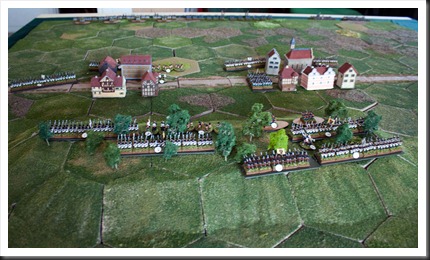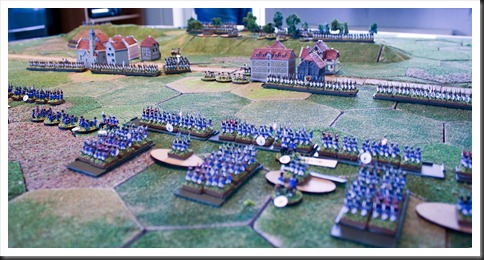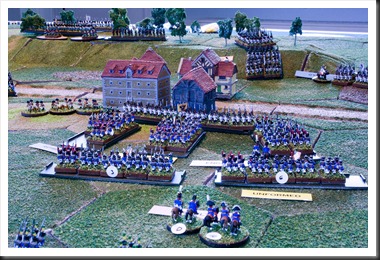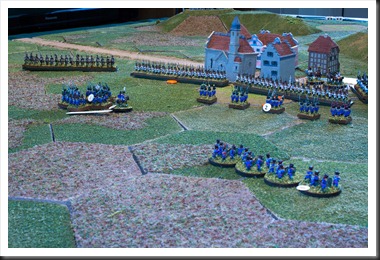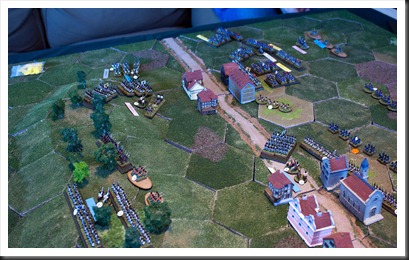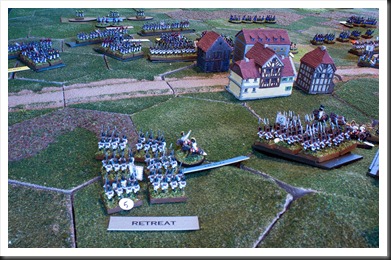Well, it finally happened – if one is to draw any conclusions from the somber message at the website, yesterday Forge World decided to pull the plug on Warhammer Historical. To be perfectly honest, nobody should be surprised by the decision. The surprise lies rather in the fact that the entire process took so long. After all, the writing was on the wall the second Games Workshop closed down "real" Warhammer Historical and gave the custody of its rulesets to Forge World. Lukewarm reception of WAB2 and appearance of trinity consisting of "Hail Ceasar", "War and Conquest" and "Clash of Empires" (let's face it, Warhammer Ancients was what Warhammer Historical was always about) sealed the company’s fate.
Quick glance at the news boards seems to confirm my opinion - even the usually reactionary crowd at TMP seems to be receiving the news in same manner one would when hearing that a beloved relative who suffered from long and life-threatening health condition has finally passed away. Sad but expected, may WAB and all its siblings rest in peace.
How will demise of Warhammer Historical affect me personally? Only to the degree I will allow it to influence my gaming. The publications are still on my bookshelf, the miniatures are still standing in my display cabinet, Saxons in ongoing campaign will still make another attempt to cross the river as soon as I paint the buildings for the village... As far as I can see, there is really no reason for me to care about Games Workshop's decision to put Warhammer Historical to its grave.
At the same time, I can't help but feel that the whole thing really stinks. It's one thing to shut down a company you are for whatever reasons no longer interested in running. It's something completely different to shut it down without any warning and pulling down all the supporting materials (often produced by fans themselves) at the same time. The FAQ:s are gone. The erratas are gone. One can only hope that the guys at Forge World will make them available again on their own site, but at the moment there is plenty of reasons to be upset as a former WH customer.
Minondas’ adventures and mishaps in a world of historical tabletop wargames
May 25, 2012
May 21, 2012
First taste of General de Brigade
There are times when I have serious concerns about my approach to wargaming. My General de Brigade-project is a perfect case in point. I bought the ruleset some six year ago. Never read it, but decided nevertheless that it would be THE Napoleonic ruleset for me. Started painting 6mm Adler miniatures shortly after that decision and yesterday I was finally able to play my first real game.
The objective of the scenario is simple - French need to take both villages and the high ground behind them. The Austrians need to stop the French. In other words, the scenario is perfect tool for training of both the defensive and offensive tactics.
Part of the fun of Napoleonic games at this level (with individual battalions as maneuver elements) lies in the intricacies of initial deployment. General de Brigade offers full scope of possibilities in this area - battalions can deploy in line, columns of companies/divisions, squares and different types of open order/skirmish formations.
Selection of appropriate formation and correct orders (assault, engage, move, support, hold, retreat) is essential for success. My main assault formation was formed in following fashion: brigade in front was under engage orders, formed in single line, four battalions abreast, protected by its skirmish screen. It was supported by second brigade formed in columns by division to its rear. The idea behind that deployment was for front brigade to soften up Unter Laichling's defenders with musket fire. Once that goal had been achieved, the Austrians would get a taste of the bayonets of the rear brigade.
Ober Laichling would be engaged by two light battalions deployed in open order. The advantage of that formation is that troops deployed in this manner shoot as effectively as conventional line formation, but are themselves harder to hit due to looser ranks.
Austrians are initially deployed in rather predictable manner - one brigade each in and around the villages, the rest on the high ground. To my surprise, L. and H. choose to deploy their "village" brigades in front of build up areas, a decision which would have some consequences. Cavalry reserve is deployed behind the hill, out of the sight of French commander.
The moment for the assault on Unter Laichling has now arrived... and my lacking knowledge of the rules was ruthlessly exposed. While setting up my formation, I was aware of the fact that my second line would have to pass through the battalions in front. To be able to do that, both units participating in the interpenetration have however to make a so called Formation Test. Failure results in unformed units, which are pretty much helpless and need to spend one turn to reform. Horrid dice rolling resulted in five out of seven battalions becoming unformed. Luckily the two battalions that managed to keep cohesion belonged to the assault brigade. Unluckily, one of them broke due to casualties taken just before it came into contact with the Austrian line, while the other one faltered in its pre-charge test and refused to move forward. A complete French fiasco was now a fact.
In the meantime, another type of engagement took place at Uber Laichling. My light battalions, deployed in open order advanced toward Austrian position and engaged the enemy. L. countered by sending his light cavalry regiment toward my flank, forcing me to form square with my leftmost battalion. The other battalion kept on fighting and even managed to break the opposing Austrian battalion. Nevertheless, both I and my opponents recognized the fact that my position was precarious, to say the least - with cavalry threatening my flank and Austrian reinforcements with clearly hostile intentions moving toward me, it was dubious I could stay in contact with the enemy without risking total annihilation of the brigade.
"Luckily" we never found out the fate of my stranded assault force and its exposed flank protectors, because at that time we decided to break off the engagement due to usual bane of all inconclusive tabletop battles - we were hungry and wanted to eat dinner. :-)
Another thing worth mentioning is that the basics rules do make perfect sense and are therefore quite easy to absorb. Command and control, movement, formation changes and firing are based on simple game mechanics, which most players should be able to memorize without difficulties after a couple of games. Charges and melees do seem a bit involved and require some fiddling with distances between units and morale checks, but I guess it's unavoidable for a ruleset at this unit level. The difficult part will be in remembering all the "chrome" rules of which there are quite a few, but since they add value to the game, then even that should be achieved with time without any problems. Overall, we all agreed that General de Brigade is a solid ruleset and we are looking forward to next French attempt to take those pesky villages of Laichling.
The scenario
For the inaugural game we used first scenario from first of scenario books for General de Brigade - Hilaire's assault on villages of Ober Laichling and Unter Laichling, which were part of the battle at Eckmuhl. In my opinion it's a perfect introductory scenario to the ruleset. It is relatively small - about ten batallions and some artillery on each side. French side enjoys better troop quality, but that is balanced by Austrian advantage in regard of artillery and the fact that they field the only cavalry unit on the battlefield.The objective of the scenario is simple - French need to take both villages and the high ground behind them. The Austrians need to stop the French. In other words, the scenario is perfect tool for training of both the defensive and offensive tactics.
Initial deployments
As a French commander without a clue, I decided to keep things simple. Two brigades would concentrate on Unter Laichling, take it as quickly as possible, then press on to the hill. Austrians positioned at Ober Laichling would in the meantime be pinned down in place by my last remaining brigade and hopefully be cut off by the time I took the high ground behind them.Part of the fun of Napoleonic games at this level (with individual battalions as maneuver elements) lies in the intricacies of initial deployment. General de Brigade offers full scope of possibilities in this area - battalions can deploy in line, columns of companies/divisions, squares and different types of open order/skirmish formations.
Selection of appropriate formation and correct orders (assault, engage, move, support, hold, retreat) is essential for success. My main assault formation was formed in following fashion: brigade in front was under engage orders, formed in single line, four battalions abreast, protected by its skirmish screen. It was supported by second brigade formed in columns by division to its rear. The idea behind that deployment was for front brigade to soften up Unter Laichling's defenders with musket fire. Once that goal had been achieved, the Austrians would get a taste of the bayonets of the rear brigade.
Ober Laichling would be engaged by two light battalions deployed in open order. The advantage of that formation is that troops deployed in this manner shoot as effectively as conventional line formation, but are themselves harder to hit due to looser ranks.
Austrians are initially deployed in rather predictable manner - one brigade each in and around the villages, the rest on the high ground. To my surprise, L. and H. choose to deploy their "village" brigades in front of build up areas, a decision which would have some consequences. Cavalry reserve is deployed behind the hill, out of the sight of French commander.
The game
Events of the game can be described in a couple of sentences. My main assault force marched slowly but surely toward their destination and was immediately fired upon by H.'s 6-pounder battery. My skirmish screen rushed forward, got too close to Austrian main line and was promptly repulsed, suffering 25 percent casualties. This exposed my battalions in line to artillery fire, increasingly accurate as they closed the distance. My leftmost battalion was severely mauled and broke as soon as my formation came into Austrian musket range. It failed to recover (some bad dice rolling on my part resulted in its dispersion during the rally attempt). However, the remaining battalions of front brigade engaged in a firefight with Austrian infantry and duly forced one of opposing battalions to beat hasty retreat.The moment for the assault on Unter Laichling has now arrived... and my lacking knowledge of the rules was ruthlessly exposed. While setting up my formation, I was aware of the fact that my second line would have to pass through the battalions in front. To be able to do that, both units participating in the interpenetration have however to make a so called Formation Test. Failure results in unformed units, which are pretty much helpless and need to spend one turn to reform. Horrid dice rolling resulted in five out of seven battalions becoming unformed. Luckily the two battalions that managed to keep cohesion belonged to the assault brigade. Unluckily, one of them broke due to casualties taken just before it came into contact with the Austrian line, while the other one faltered in its pre-charge test and refused to move forward. A complete French fiasco was now a fact.
In the meantime, another type of engagement took place at Uber Laichling. My light battalions, deployed in open order advanced toward Austrian position and engaged the enemy. L. countered by sending his light cavalry regiment toward my flank, forcing me to form square with my leftmost battalion. The other battalion kept on fighting and even managed to break the opposing Austrian battalion. Nevertheless, both I and my opponents recognized the fact that my position was precarious, to say the least - with cavalry threatening my flank and Austrian reinforcements with clearly hostile intentions moving toward me, it was dubious I could stay in contact with the enemy without risking total annihilation of the brigade.
"Luckily" we never found out the fate of my stranded assault force and its exposed flank protectors, because at that time we decided to break off the engagement due to usual bane of all inconclusive tabletop battles - we were hungry and wanted to eat dinner. :-)
The ruleset
So... was my rather hasty decision to nominate General de Brigade as my Napoleonic ruleset of choice all those years ago a correct one? It's far too early to give a definitive answer to that question, but the first impression is absolutely a positive one. There is nothing revolutionary about this set of rules, in fact I would go as far as saying that it's rather conventional both in regard of game sequence and mechanics. However, it has to be said the same time that it manages to deliver that distinct Napoleonic feeling and that is the main selling point for me.Another thing worth mentioning is that the basics rules do make perfect sense and are therefore quite easy to absorb. Command and control, movement, formation changes and firing are based on simple game mechanics, which most players should be able to memorize without difficulties after a couple of games. Charges and melees do seem a bit involved and require some fiddling with distances between units and morale checks, but I guess it's unavoidable for a ruleset at this unit level. The difficult part will be in remembering all the "chrome" rules of which there are quite a few, but since they add value to the game, then even that should be achieved with time without any problems. Overall, we all agreed that General de Brigade is a solid ruleset and we are looking forward to next French attempt to take those pesky villages of Laichling.
Subscribe to:
Posts (Atom)
